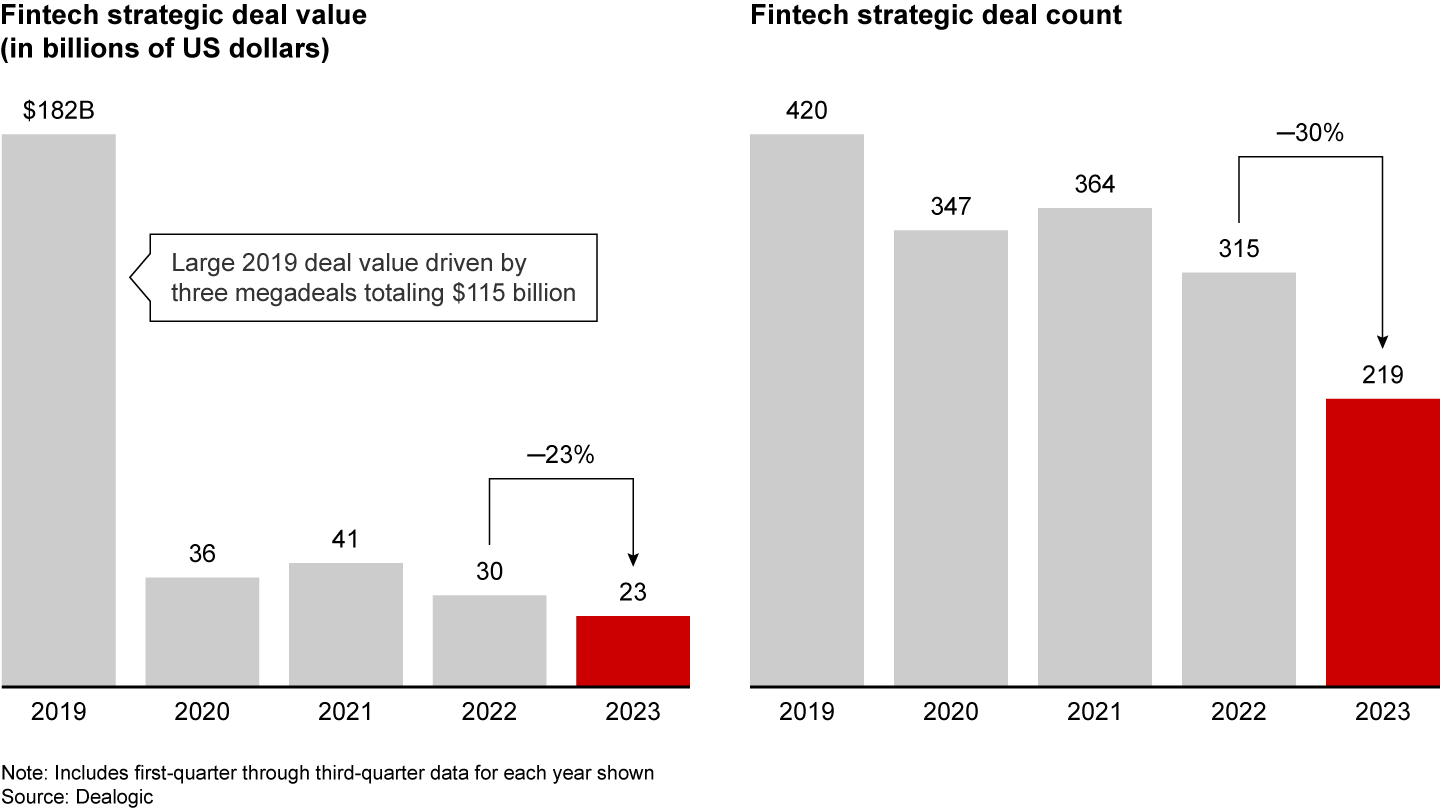M&A Report
 }
}
At a Glance
- Payments companies are cherry-picking assets in capability deals to advance the industry’s evolution, complementing payments with working capital.
- Small deals in major global markets such as France as well as new opportunities in smaller markets aim at expanding geographic reach.
- More incumbents are looking to separate their payments business to create standalone entities that trade at higher multiples.
- Investor impatience and small, attractive fintech companies low on cash will likely lead to heightened dealmaking in 2024.
This article is part of Bain's 2024 M&A Report.
On the surface, it seems as if the year 2023 was less frothy than recent years. Overall, deal value for fintechs dropped 23% and volume fell 30% over the first nine months of 2023 (see Figure 1). Yet, look beneath this calm surface, and you’ll see furious activity against many smaller assets and an industry quietly growing via M&A in a variety of interesting ways. The activity represents three key themes: geographic expansion, deals for adjacent capabilities, and large-scale separations.

Some of the geographic expansion took place in larger markets. Global fintech Rapyd bought PayU GPO to enhance its presence in Latin America and Europe, for example, while France-based Market Pay acquired Polish paytech Novelpay, including its French subsidiary PAX France Novelpay.
But the expansion also encompassed previously untapped markets as global demand surged for modern digital payment options. In Uzbekistan, for example, Georgia’s TBC Bank acquired the remaining 49% share in Inspired, which operates under the Payme brand.
In addition to this global expansion, companies are cherry-picking assets that add capabilities as the industry evolves from cards to digital payments to adjacencies—namely, everything from payroll to disbursement to small business services, complementing payments with working capital. For example, the objective of Nuvei’s acquisition of Paya was to add integrated payment and business-to-business capabilities. In credit processing, Marqeta expanded beyond debit and prepaid with its acquisition of Power Finance.
And despite the industry’s fragmentation, there was a shortage of consolidation plays in 2023. Many banks were distracted by the need to upgrade to new data standards and formats and other regulatory issues, so only the largest and most strategic banks turned to M&A or partnerships to grow. More common were deals similar to Fifth Third Bancorp’s acquisition of Rize Money, an embedded payments platform that provides payment infrastructure and risk management capabilities to fintechs.
Instead of acquiring, more industry incumbents are looking to unlock value by separating their payments business to create standalone entities that trade at higher multiples. Fidelity National Information Services (FIS) divested a majority stake in Worldpay to private equity firm GTCR. Barclays is exploring the sale of a stake in the unit that processes payments for UK merchants and is seeking a partner to help grow that business.
The year 2023 also saw fewer distressed acquisitions than many anticipated. Among the exceptions: Payments processing giant FIS acquired the banking-as-a-service start-up Bond Financial Technologies.
But it’s unclear how much longer cash-strapped smaller companies can hold out as they deplete runway. Indeed, the combination of investor impatience and smaller, attractive fintech companies low on cash will likely lead to heightened dealmaking in 2024, benefiting well-capitalized payment conglomerates and incumbents as they tuck in assets that accelerate their strategic initiatives. Our survey of M&A practitioners found that the business need for cash on hand is much more important for financial services companies than other industries when deciding to bring assets to market.
We expect stronger and larger payments companies, many of which are eager to enhance their innovation capabilities and talent pools, to be more active than banks in the year ahead. Banks are likely to turn to less capital-intensive partnerships as an alternative to traditional M&A.
What does this mean for buyers and sellers?
For the consolidators, there is a window of opportunity to absorb competitors at less stratospheric prices, particularly those that are unwilling or unable to invest to maintain their competitiveness. This may unlock new opportunities to carve out banks' underinvested merchant acquiring businesses, for example.
For the capability hungry, purchasing high-quality assets will require bold approaches. A deep understanding of the true value of the capabilities, such as the new customer segments and cross-selling opportunities they unlock, will help them make offers that get their targets to the table without overpaying.
For potential sellers, the key will be getting to maturity and profitability (or at least on a clear path to profitability) as fast as possible. The environment has much less tolerance for cash-burning models.
Above all, the best acquirers will anchor their M&A in strategy and be deliberate about market scanning, due diligence, and integration efforts. Leading organizations will plan for opportunities long before they arise by building a target pipeline (regardless of whether or not they are available) and systematically cultivating relationships with high-priority targets.
A combination of commercial and technology due diligence will help ensure that the asset quality is as advertised. That gives the potential purchaser a clear understanding of how to monetize the asset, or the opportunity to walk away if the signs are negative.
It is also critical to be extremely intentional about integration. Many acquirers have created destructive complexity in the process of bringing small assets together and into the fold. Or alternatively, those assets get lost within the organization, with no real idea of how they will fit into the acquirer’s portfolio. In either case, the buyer isn’t able to generate the true value of the acquisition.
